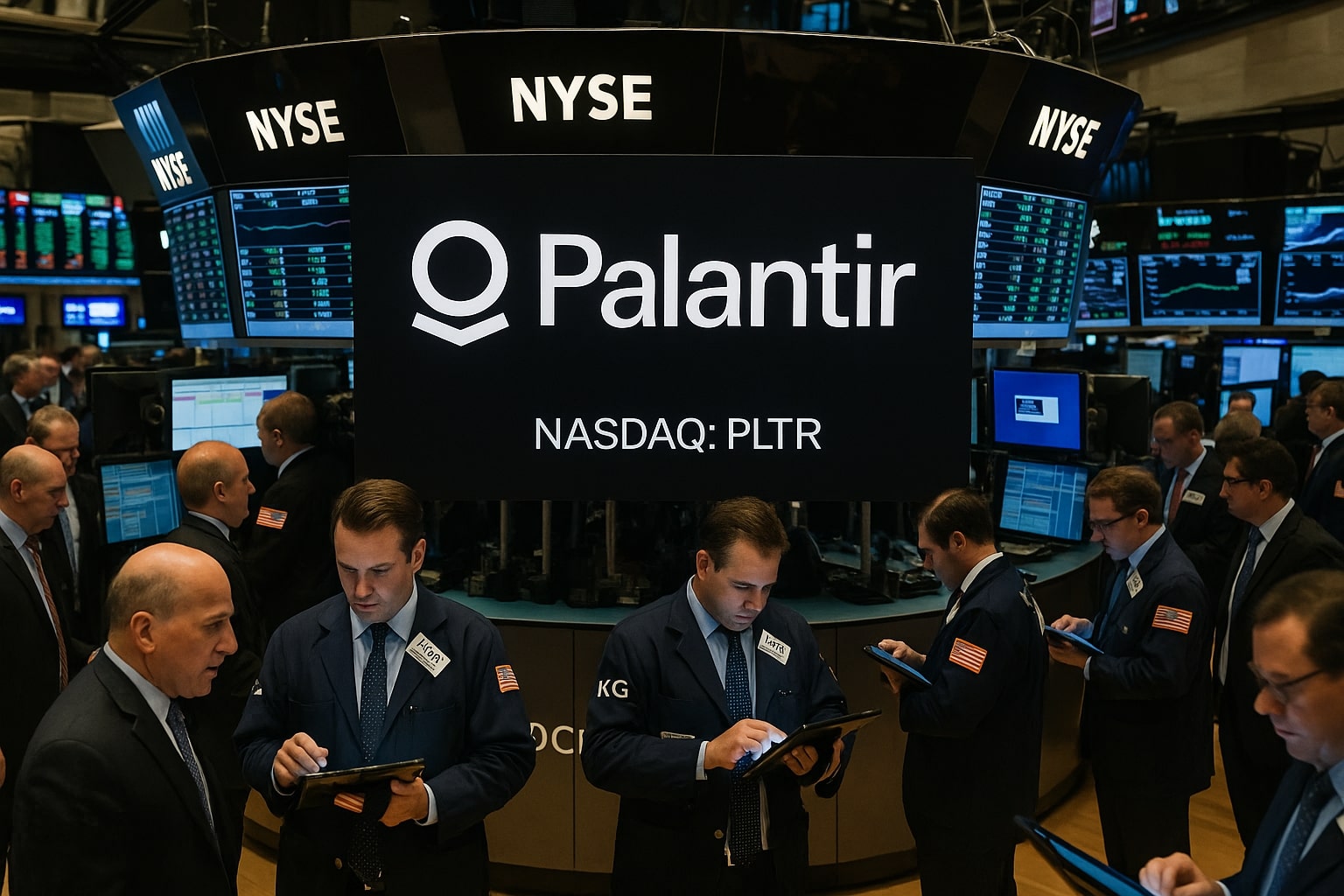Palantir Technologies Inc. (NASDAQ:PLTR): A Deep Dive into Its Market Position, Valuation, and Growth Potential
Palantir's Current Market Overview
Palantir Technologies Inc. (NASDAQ:PLTR) has become a market phenomenon, now boasting a market capitalization of around $300 billion. The company is firmly positioned as the most expensive mega-cap ever, with a forward price-to-earnings (P/E) ratio exceeding 200x and a price-to-sales (P/S) ratio surpassing 77x as of May 2025. Such valuations are typically reserved for high-growth tech stocks, but Palantir's fundamental strengths lie in its high-margin, AI-driven platform, which has allowed it to grow rapidly in the government and enterprise software markets. Despite its impressive performance, PLTR is also facing increasing scrutiny from analysts, many of whom believe the stock is priced for perfection.
Is Palantir Overvalued or Poised for Long-Term Growth?
The key question surrounding NASDAQ:PLTR stock is whether it has reached its peak valuation or if it still has room to grow. The recent bullish sentiment has been driven largely by a combination of AI hype and Palantir's unique positioning within the government and commercial sectors. However, the company faces significant risks in maintaining its valuation as the stock trades at one of the highest multiples in the market. A comparison to previous market darlings like NVIDIA (NVDA) and Tesla (TSLA) suggests that while overvaluation is a concern, Palantir could still surprise investors with continued outperformance if it executes successfully. PLTR's growth narrative is closely tied to its AI platform, AIP, which is expected to revolutionize enterprise productivity, much like Nvidia’s dominance in the AI chip market.
Palantir's Strong AI Growth Narrative and Competitive Risks
Palantir's AI-driven platform has become its core differentiator in the tech space, particularly in the fields of defense, healthcare, and enterprise software. The company’s artificial intelligence platform, AIP, is marketed as a solution capable of making businesses exponentially more productive. As of 2025, PLTR's U.S. commercial business has reached a $1 billion annual run rate, growing 71% year-over-year. The firm’s ability to convert pilot programs into multi-million-dollar, multi-year contracts is a significant competitive advantage. However, the company is not without risks. With AI progressing rapidly, competitors are beginning to enter the space, and PLTR’s current AI dominance might be challenged. Despite this, Palantir’s stronghold on government contracts and its high-margin business model continue to support its long-term prospects.
Commercial Growth: The U.S. Segment Leads the Charge
The major driver of Palantir's growth has been its U.S. commercial segment, which has gained significant traction over the past year. As of Q1 2025, Palantir secured 139 contracts valued at over $1 million, with 31 of them exceeding $10 million. The company’s deal pipeline is bolstered by multi-million-dollar contracts with companies in sectors ranging from healthcare to finance. This enterprise expansion is critical for Palantir’s long-term success as it shifts from its reliance on government contracts. Despite the impressive growth in the U.S., international markets have lagged, particularly in Europe, where regulatory hurdles and AI skepticism have slowed adoption. This geographic imbalance highlights the risks associated with Palantir's expansion, with its reliance on the U.S. market putting the company at risk if U.S. government spending or enterprise AI adoption falters.
Technical Analysis and Valuation Concerns
From a technical standpoint, NASDAQ:PLTR has been experiencing a volatile price trajectory. The stock recently reached a double top at $125, a point of resistance that has caused some investors to question whether the stock is overbought. Valuation remains a critical concern, with the stock trading at a forward P/E ratio of over 200x. PLTR's growth expectations have been priced into the stock, and the company needs to exceed these expectations to justify its current valuation. The Rule of 40—which combines a company’s revenue growth rate and profit margin—is a key metric for evaluating the company’s efficiency. Palantir has an 83% Rule of 40 score, which places it in the top tier of software companies. This indicates that the company is both growing quickly and generating significant cash flow. However, such high growth and high valuation could lead to dramatic multiple compression if the company fails to meet expectations in future quarters.
Financial Performance and Growth Outlook
Palantir's Q1 earnings report showcased a continuation of strong growth in both government and commercial sectors. With government contracts accounting for 55% of revenue, PLTR remains a dominant player in this space. The company expects total revenue for FY 2025 to grow by approximately 31%, reaching around $3.9 billion. However, despite these positive projections, the market is concerned about the sustainability of this growth. The stock’s high P/E ratio and P/S ratio indicate that much of Palantir's future growth is already priced in. The company needs to maintain its rapid growth trajectory, particularly in its U.S. commercial business, to justify its current valuation. Analysts are watching closely for signs of continued execution, particularly in enterprise adoption and government renewals, which will be critical for future growth.
The Bear Case: Is Palantir's Valuation Justified?
Despite the company’s impressive fundamentals, the bear case for NASDAQ:PLTR is gaining traction. Critics argue that Palantir's valuation is unsustainable, with its P/E ratio far outpacing the growth of its earnings. Similar to Tesla (TSLA) and Nvidia (NVDA) in their earlier years, Palantir is facing the challenge of maintaining high valuations as it matures as a company. The market is pricing PLTR as a high-growth, high-margin platform business, but any deviation from the company’s guidance or a slowdown in enterprise adoption could lead to a sharp correction in the stock price. Furthermore, concerns about dilution and the concentration of revenue from a small group of clients raise questions about the stability of Palantir's revenue base. If Palantir fails to meet expectations in the coming quarters, the stock could face significant downside risk.
The Bull Case: Palantir's Strong Market Position and AI Dominance
On the other hand, the bull case for Palantir hinges on its unique position as an AI infrastructure provider. With Palantir's ontology-driven AI platform, AIP, the company has a distinct competitive advantage that sets it apart from other AI players. The government’s increasing adoption of Palantir's technology, coupled with expanding commercial contracts, positions the company well for continued growth. PLTR's ability to secure multi-year, multi-million-dollar contracts is a key factor in its bullish outlook. Moreover, the company’s strong free cash flow and asset-light business model provide a solid foundation for future growth without the need for significant capital expenditure. If Palantir continues to dominate in its AI infrastructure space, particularly in defense and enterprise, the stock could see significant upside in the coming years.
Palantir’s Long-Term Potential: A Buy, But Priced for Perfection
Despite concerns over valuation and competition, Palantir Technologies Inc. (NASDAQ:PLTR) remains a promising investment for those willing to bet on the continued growth of AI-driven enterprise software. With its strong position in both the government and commercial sectors, PLTR is well positioned for future expansion. However, the stock’s current valuation suggests that much of the company’s future growth is already priced in. For Palantir to justify its premium valuation, it will need to consistently meet or exceed expectations, particularly in terms of revenue growth and commercial adoption. Investors should remain cautious but optimistic, with the potential for a surprise outperformance if Palantir continues to execute on its ambitious growth strategy.



















